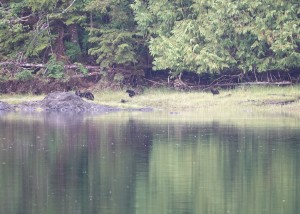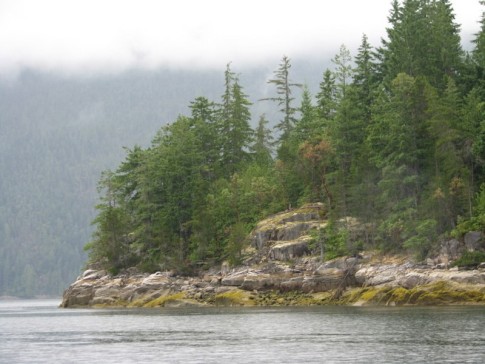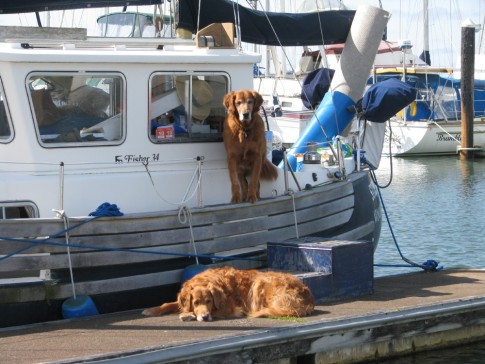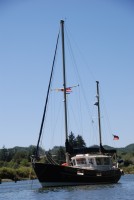Sirius Sailin'
| Vessel Name: | Storm Petrel |
| Vessel Make/Model: | Fisher 34 |
| Hailing Port: | Winchester Bay, Oregon |
| Crew: | Fraser and Jeff |
| About: | Additional Crew: Zac and Indy |
| Extra: | Storm Petrel is a 1977 Pilothouse ketch. She has sailed the Oregon/Washington coast since 1999, now home port is Pleasant Harbor, WA. |
30 September 2023
uly 24 - 25 A Rollicking Ride Down Hecate Strait to Cumshewa Inlet & Gordon Cove (53° 02.5’N, 132° 01.6’W) First Quarter Moon
The early morning was gorgeous! We got underway at 05:35 under thin, broken overcast skies with very light wind. The "Sleeping Beauty," a profile of a supine female form seen in the configuration of the mountain tops to the NW appeared navy blue in the early morning light. The gauzy white overcast was [...]
30 September 2023
July 23– Daajing Giids, Bearskin Bay, Queen Charlotte Harbor (53° 15.1’N, 132° 4.7’W) Waxing Cresent Moon
We left the marina by midafternoon with the intention of repositioning to the fuel dock adjacent to the marina in time to meet the attendant’s hours, 16:00-20:00 to this time of year. Before casting off the lines, we realized that the external regulator was not powered. Jeff did some troubleshooting [...]
30 September 2023
uly 21 – 22 Daajing Giids, Queen Charlotte Harbor (53° 15.2’N, 132° 4.4’W)
Although Jeff and I prefer to anchor out, being at a marina has advantages. It is easier to walk Zac and Indy at any time, engage in boat repairs and maintenance, explore the surrounding area, and of course, it is always nice to have a hot shower with plentiful water, that is, if one has enough “Loonies” [...]
Gunkholing in the Rivers Inlet and Fitz Hugh Sound Region
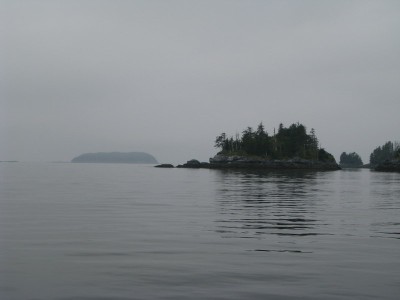
29 July
As we motored through Hakai Passage to Fitz Hugh Sound we enjoyed watching a lone humpback whale repeatedly slapping his/her tail and sending gallons of water into the air. The 1 meter following sea rolled under our stern giving us a boost toward Goldstream Harbour (N 51° 43.6' W 128° 00.25'), our destination for the evening. Sometimes the waves caught the stern in such a way that it felt like we were surfing. Goldstream Harbour, just like every other inlet, cove, bay, and nook and cranny we've visited had a unique feel and atmosphere. Goldstream was a secure and beautiful harbor. It was graced with a white shell, midden beach on the north side of the entrance and another at its head, and a couple of picturesque passes into the outer waters of Hakai Passage. The small passages allowed a peek at the nearby conditions before leaving the comfort of the anchorage and created a marvelous frame for the spectacular red and purple sunset that evening. The beach at the entrance was covered with driftwood, some polished smooth by emersion in the water and other pieces carved by nature into fantastic shapes.
A pretty little fishing boat converted for cruising was already anchored in the harbor when we arrived. One of the crewmembers came over to say hi and relayed to us that he and his wife once owned a Fisher 30 based in Comox, B.C. prior to their current boat. The couple, cruising since May, was returning to Comox after visiting southeastern Alaska waters. After a dinghy tour of the harbor and a visit to one of the midden beaches, we enjoyed a fresh red rock crab appetizer, followed by even fresher salmon cooked on the grill with a little hickory smoke. Canned veggies have a hard time competing with a main course like that!
30 July
Leaving Goldstream Harbor, we turned right heading down Fitz Hugh Sound toward our next destination. As we motored down the Sound against a 10 knot headwind, we were thrilled again and again to see humpback whales feeding. When feeding, the whales are focused and don't exhibit much in the way of dramatic, acrobatic display behaviors. However, seeing them in their natural habitat, merely knowing they are present in the surrounding water, engenders feelings of joy and affirms "reverence for life."
We ventured up Darby Channel, a narrow channel between Walbran Island and the mainland, which is lush with evergreens and superbly scenic. Darby ends at its northeast extremity in Rivers Inlet. The inlet is famous for salmon fishing and the lodges that are supported by the sport fishing industry. One of the important changes occurring here as well as other areas is the decline of the salmon. The five species of salmon native to the waters of British Colombia are central to life here. They represent sustaining life for all the other species present, including humans. The First Nations people revered the salmon in their lives and their culture as a cornerstone to their way of life. Now, human animals, along with all the species depending on the salmon are on the brink of a major change as the wild populations of salmon decline to levels never before seen. One of the sights we see in many bays and inlets in this area are salmon farms.
Aquaculture or farming of Atlantic salmon has become a huge threat to the salmon native to this area and to the salmon-dependent species, such as orcas, as well. Salmon are farmed in open net pens in waters where wild salmon transit both on their way to the open ocean as smolts and then again as they return to the rivers they were born in to spawn and die, culminating their life cycle. The farmed Atlantic salmon is fed a food pellet made from fish oil, krill, and other by-products along with a huge dose of antibiotics. Aquaculture science has determined that it takes about 2.5 pounds of protein in the form of food pellets to produce a single pound of farmed salmon protein, not a very economic venture. The salmon farms have severely reduced the wild population of salmon through pollution from wastes, excess food and medications, and the increase of parasite species, and by weakening wild stocks with hybrids from escaped Atlantic salmon. The Canadian government continues to grant aquaculture permits, seemingly turning a blind eye to the science that illustrates the threat. The Canadian public has ceased to purchase farmed salmon, yet the farms prosper with the huge international market next door in the United States.
Anyway, (we'll get off our soap box) near the Rivers Inlet end of Darby Channel is Dawson's Landing. The Landing is a floating outpost with a few cabins for rent, fuel, groceries at a charming store, and good tasting water. There is even a regular float plane that serves Dawson's Landing and the surrounding area three times a week. We stopped briefly to pick up some fresh groceries, refill our water tanks, and most importantly, eat ice cream bars! Additionally, we were able to pick up a spare shear pin for the dinghy motor. In all his years of operating boats, Jeff had never broken a shear pin until now. Twice in the space of a few days he hit first a small submerged piece of drift wood and then a submerged rock that was just high enough to graze the prop as we went past.
After visiting Dawson's Landing we headed down Rivers Inlet and into Johnston Bay, a beautiful little body of water almost completely surrounded by tree-covered hills. The entire bay was quite deep, 70 feet or deeper, which requires a lot of chain to anchor safely. We usually employ four or five times the depth in scope. We do have enough chain and don't mind using it, but it can be a pain to deal with that much chain when it comes to stowing it as the anchor is weighed. Our chain locker is just big enough to hold our 300 feet of chain and 100 feet of nylon rode, but it is not very deep. The chain piles up quickly in the middle of the locker when we raise the anchor with the windlass, requiring one of us to be in the V-berth to distribute the chain around the sides of the locker as it comes down from the windlass gypsy.
As we slowly progressed toward the very end of Johnston Bay, we recognized the remains of an old log float secured to a dolphin of pilings by chain and then to shore by a couple of burly lines tied to trees. We decided to use our anchor for our primary security, but took a stern line to the float logs to keep us from swinging. The bay was very quiet with none of the inlet's winds finding their way to ripple the waters around Storm Petrel. The only disturbances were from numerous salmon breaking the surface as they fed on herring that they had cornered in the shallows against the rocky shoreline of the head of the bay. We were fascinated to watch the big fish swim by us, but none were the least interested in any of the many lures Jeff presented them. An eagle fished in the evenings near the boat as did several young seals. We were also delighted by the presence of a great blue heron that stood silently on shore as we tied to the log float.
The bay had abundant wildlife, particularly birds. We enjoyed a couple of days in this lively anchorage. The nights were spectacular with stars galore before fog drifted down the slopes into the bay in the wee hours of the morning. The moon rose above the trees late in the evening making it easy to check the anchor and stern tie around midnight.
We placed our crab pot in several different spots in the harbor. It enticed a humongous purple sun star but no crabs. Sun stars seem to have a bazillion legs and really look like the stuff of horror movies: "The sun star that ate Tokyo" or something of that magnitude!
The forecast for August 1st again called for strong winds blowing down Queen Charlotte Sound, so we traveled back through Darby Channel to Klaquaek Channel, a picturesque passage between Walbran and Penrose Islands. While still in Rivers Inlet we had another thrilling, surprise sighting of humpbacks. Three whales charging west through the inlet suddenly surfaced and explosively exhaled just off our starboard beam. We were sailing downwind under a straining jib enjoying the exhilarating hiss associated with briskly moving through the water. The vapor from the whales' blows quickly dispersed in the wind but the thunderous sound reverberated throughout the cockpit for some time afterward. We hadn't seen them coming through the two foot chop and they vanished just as quickly as we plowed up the inlet.
On the east side of Penrose Island is Fry Pan Bay and Big Fry Pan Bay. We poked our nose into the smaller Fry Pan Bay and found that there were already a couple of boats anchored, so we continued around to Big Fry Pan Bay. There were also a couple of boats anchored in the larger portion of this bay, but we noticed two nooks in the southern end of the bay that were quite secluded. We chose the easternmost of the two and eased our way into the middle between two rock outcroppings. The biggest waves in the cove during the entire time we were there were from our anchor breaking the smooth surface as it was lowered from the bow roller. This quiet, private sanctuary had everything we needed: the beauty of sheltering hills, covered to the water's edge in hemlock, spruce, and cedar; a grass covered peninsula to take the dogs for their outings in the morning and evening; and a lovely view of the outer bay. With the "Relief Rock" yards from the boat, we simply rowed the dogs to shore or they swam from the dinghy. All three are very nimble and well able to jump from the deck into the dinghy and vice versa. As soon as they hear permission to "go swim," they launch themselves from the dinghy's bow or sides and then it's full speed ahead to shore. They always leave us laughing in their wakes. The dogs really enjoyed the swimming and playing in the little cove and because they had lots of exercise, we were all able to relax a bit on deck in the afternoons. The hammock was in great demand.
This cove was so pleasant that we ended up staying for four nights. Each night, Illumination from the almost full moon cast a pearly glow around the cove, highlighting bare trees and giving the water in the larger bay a silver tint. Biting bugs appeared with twilight but were thwarted in making us their meals by fine screening that we taped to any ports we kept open. We had good luck with our crab pot in this cove. It yielded four big dungenous crabs that were absolutely delicious! Jeff also took the dinghy out one afternoon and caught a rockfish for dinner that night.
Finally, the weather improved a little and we were able to head back down towards Vancouver Island. We were underway by 06:55 on the fifth of August heading out Fitz Hugh Sound. As we entered the sound, we were delighted to see a pair of humpback whales in the distance, a cow with her calf. What first caught our attention was the splash created by the calf's tail slapping. The whales went into stealth mode and we continued on in an attempt to disturb them as little as possible. The weather was a bit drizzly with a very low ceiling (about 50 feet), but the visibility was at least a couple of miles. The sea was a lumpy until we had been underway for a couple of hours. After the last few days of quiet anchorages, the two to three foot chop was a little uncomfortable at first. Cookies, specifically Newman-O's, helped to quell any queasiness. We were able to make good time with the help of the current from the flooding tide and passed Cape Caution around noon. The seas continued to subside until we were enjoying a low NW swell as we traveled down the coast to Allison Harbour. We arrived by 14:40, giving us time to let the dogs have a good swim, explore several interconnected channels by dinghy, and enjoy looking at different types of sea stars clinging to the rocks along a portion of the shore. We saw bat stars for the first time this summer. The harbor seemed to attract moon jellyfish to its calm waters. The jellies floated in large schools at varied depths and from an imaginative point of view, seemed to dance like ballerinas in pink and white tutus. There were two other sailboats when we anchored toward the end of the long harbor upon arrival. By the time we took the dogs for a last shore leave around 21:00, there were seven other boats anchored in the bay with us, the most company we've had since we were at the marina in Shearwater.
We were underway with everything stowed by 06:36, headed out to cross Queen Charlotte Strait, bound for Port Hardy. The morning brought a cool, drizzly, low hanging fog, but thankfully, visibility was at least a quarter mile even at its lowest. The air was quite calm and the water so smooth that it mirrored the fog creating the impression of empty space until a small islet would materialize as we neared it. It was very comforting to have the radar enabling us to see every obstacle along our route. The glassy surface of the water allowed the radar to show every bit of floating debris, including bits of kelp and even the birds. As we wove our way through the last string of islands before reaching Vancouver Island, with Casey on lookout duty at the bow, we were approached by a couple of speeding dolphins. They had been foraging in the channels but seemed to briefly entertain the notion of riding our bow wave. They only played in the wave for a moment or two before moving away and disappearing from view. Perhaps Storm Petrel's speed of 5 knots wasn't enticing enough for a ride.
We arrived at Port Hardy at 11:37 and were assigned a slip alongside the second float out from the head of the dock at the Quarterdeck Marina. The fairway between floats is very narrow and since we were all the way in toward the main dock, we wanted to turn around so our departure would be easier. It was close with a boat on the neighboring float, but Storm Petrel turned on her full keel without scraping either end!
